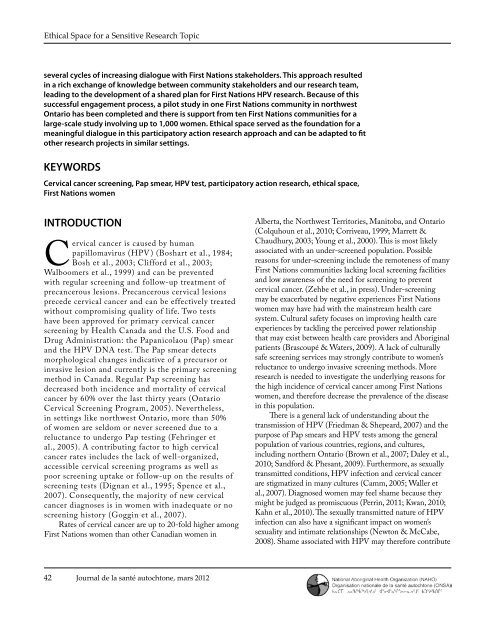Ethical Space for a Sensitive Research Topic - National Aboriginal ...
Ethical Space for a Sensitive Research Topic - National Aboriginal ...
Ethical Space for a Sensitive Research Topic - National Aboriginal ...
Create successful ePaper yourself
Turn your PDF publications into a flip-book with our unique Google optimized e-Paper software.
<strong>Ethical</strong> <strong>Space</strong> <strong>for</strong> a <strong>Sensitive</strong> <strong>Research</strong> <strong>Topic</strong><br />
several cycles of increasing dialogue with First Nations stakeholders. This approach resulted<br />
in a rich exchange of knowledge between community stakeholders and our research team,<br />
leading to the development of a shared plan <strong>for</strong> First Nations HPV research. Because of this<br />
successful engagement process, a pilot study in one First Nations community in northwest<br />
Ontario has been completed and there is support from ten First Nations communities <strong>for</strong> a<br />
large-scale study involving up to 1,000 women. <strong>Ethical</strong> space served as the foundation <strong>for</strong> a<br />
meaningful dialogue in this participatory action research approach and can be adapted to fit<br />
other research projects in similar settings.<br />
KEYWORDS<br />
Cervical cancer screening, Pap smear, HPV test, participatory action research, ethical space,<br />
First Nations women<br />
INTRODUCTION<br />
C<br />
ervical cancer is caused by human<br />
papillomavirus (HPV) (Boshart et al., 1984;<br />
Bosh et al., 2003; Clif<strong>for</strong>d et al., 2003;<br />
Walboomers et al., 1999) and can be prevented<br />
with regular screening and follow-up treatment of<br />
precancerous lesions. Precancerous cervical lesions<br />
precede cervical cancer and can be effectively treated<br />
without compromising quality of life. Two tests<br />
have been approved <strong>for</strong> primary cervical cancer<br />
screening by Health Canada and the U.S. Food and<br />
Drug Administration: the Papanicolaou (Pap) smear<br />
and the HPV DNA test. The Pap smear detects<br />
morphological changes indicative of a precursor or<br />
invasive lesion and currently is the primary screening<br />
method in Canada. Regular Pap screening has<br />
decreased both incidence and mortality of cervical<br />
cancer by 60% over the last thirty years (Ontario<br />
Cervical Screening Program, 2005). Nevertheless,<br />
in settings like northwest Ontario, more than 50%<br />
of women are seldom or never screened due to a<br />
reluctance to undergo Pap testing (Fehringer et<br />
al., 2005). A contributing factor to high cervical<br />
cancer rates includes the lack of well-organized,<br />
accessible cervical screening programs as well as<br />
poor screening uptake or follow-up on the results of<br />
screening tests (Dignan et al., 1995; Spence et al.,<br />
2007). Consequently, the majority of new cervical<br />
cancer diagnoses is in women with inadequate or no<br />
screening history (Goggin et al., 2007).<br />
Rates of cervical cancer are up to 20-fold higher among<br />
First Nations women than other Canadian women in<br />
42 Journal de la santé autochtone, mars 2012<br />
Alberta, the Northwest Territories, Manitoba, and Ontario<br />
(Colquhoun et al., 2010; Corriveau, 1999; Marrett &<br />
Chaudhury, 2003; Young et al., 2000). This is most likely<br />
associated with an under-screened population. Possible<br />
reasons <strong>for</strong> under-screening include the remoteness of many<br />
First Nations communities lacking local screening facilities<br />
and low awareness of the need <strong>for</strong> screening to prevent<br />
cervical cancer. (Zehbe et al., in press). Under-screening<br />
may be exacerbated by negative experiences First Nations<br />
women may have had with the mainstream health care<br />
system. Cultural safety focuses on improving health care<br />
experiences by tackling the perceived power relationship<br />
that may exist between health care providers and <strong>Aboriginal</strong><br />
patients (Brascoupé & Waters, 2009). A lack of culturally<br />
safe screening services may strongly contribute to women’s<br />
reluctance to undergo invasive screening methods. More<br />
research is needed to investigate the underlying reasons <strong>for</strong><br />
the high incidence of cervical cancer among First Nations<br />
women, and there<strong>for</strong>e decrease the prevalence of the disease<br />
in this population.<br />
There is a general lack of understanding about the<br />
transmission of HPV (Friedman & Shepeard, 2007) and the<br />
purpose of Pap smears and HPV tests among the general<br />
population of various countries, regions, and cultures,<br />
including northern Ontario (Brown et al., 2007; Daley et al.,<br />
2010; Sand<strong>for</strong>d & Phesant, 2009). Furthermore, as sexually<br />
transmitted conditions, HPV infection and cervical cancer<br />
are stigmatized in many cultures (Camm, 2005; Waller et<br />
al., 2007). Diagnosed women may feel shame because they<br />
might be judged as promiscuous (Perrin, 2011; Kwan, 2010;<br />
Kahn et al., 2010). The sexually transmitted nature of HPV<br />
infection can also have a significant impact on women’s<br />
sexuality and intimate relationships (Newton & McCabe,<br />
2008). Shame associated with HPV may there<strong>for</strong>e contribute






